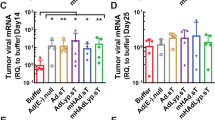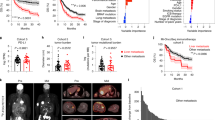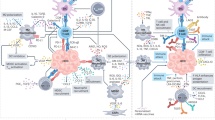Abstract
In humans, no efficient treatment exists not only against multifocal liver metastases (LM) but also against recurrent microscopic liver metastases within the liver remnant following curative liver resection. Furthermore, in nonmultifocal LM, partial liver resection could be performed, but in more than 50% of the patients, tumor recurrence within liver remnant is observed, partly due to the growth of dormant cancer cells in the setting of postoperative host immune dysfunction. We investigated the therapeutic potential of interleukin-12 (IL-12) immuno-gene therapies in these experimental models under total vascular exclusion (TVE) of the liver. In rats with multiple LM of DHDK12 colon cancer cells, we observed a significant reduction in tumor volume after retroviral-mediated gene transfer of either herpes simplex virus thymidine kinase (HSV1-TK) and ganciclovir (GCV) administration, or IL-12. Combined treatment with HSV1-TK/GCV and IL-12 resulted in improved tumor volume reduction and even survival. In rats with recurrent microscopic DHDK12 LM established after partial liver resection, we observed significantly decreased recurrent tumor volumes and increased survival after retroviral-mediated IL-12 gene transfer. In both settings, immunohistological analysis revealed that IL-12 immuno-gene therapy was accompanied by an infiltration of CD8+ T lymphocytes within the tumors. Altogether, our results suggest that IL-12 adjuvant gene therapy could improve the management of patients with either resectable or unresectable LM.
This is a preview of subscription content, access via your institution
Access options
Subscribe to this journal
Receive 12 print issues and online access
$259.00 per year
only $21.58 per issue
Buy this article
- Purchase on Springer Link
- Instant access to full article PDF
Prices may be subject to local taxes which are calculated during checkout










Similar content being viewed by others
References
Adam R, Laurent A, Azoulay D, et al. Two-stage hepatectomy: a planned strategy to treat irresectable liver tumors. Ann Surg. 2000;232:777–785.
Caruso M, Panis Y, Gagandeep S, et al. Regression of established macroscopic liver metastases after in situ transduction of a suicide gene. Proc Natl Acad Sci USA. 1993;90:7024–7028.
Kianmanesh AR, Perrin H, Panis Y, et al. A “distant” bystander effect of suicide gene therapy: regression of nontransduced tumors together with a distant transduced tumor. Hum Gene Ther. 1997;8:1807–1814.
Freeman SM, Ramesh R, Shastri M, et al. The role of cytokines in mediating the bystander effect using HSV-TK xenogeneic cells. Cancer Lett. 1995;92:167–174.
Alves A, Charre L, Panis Y, et al. Total vascular exclusion of the liver enhances the efficacy of retroviral-mediated associated thymidine kinase and interleukin-2 genes transfer against multiple hepatic tumors in rats. Surgery. 2003;133:669–677.
Kemeny N, Huang Y, Cohen AM, et al. Hepatic arterial infusion of chemotherapy after resection of hepatic metastases from colorectal cancer. N Engl J Med. 1999;341:2039–2048.
Panis Y, Ribeiro J, Chretien Y, et al. Dormant liver metastases: an experimental study. Br J Surg. 1992;79:221–223.
Tanaka M, Saijo Y, Sato G, et al. Induction of antitumor immunity by combined immunogene therapy using IL-2 and IL-12 in low antigenic Lewis lung carcinoma. Cancer Gene Ther. 2000;7:1481–1490.
Narvaiza I, Mazzolini G, Barajas M, et al. Intratumoral coinjection of two adenoviruses, one encoding the chemokine IFN-gamma-inducible protein-10 and another encoding IL-12, results in marked antitumoral synergy. J Immunol. 2000;164:3112–3122.
Rosenberg SA, Lotze MT, Yang JC, et al. Experience with the use of high-dose interleukin-2 in the treatment of 652 cancer patients. Ann Surg. 1989;210:474–484 discussion 484–475.
Siegel JP, Puri RK . Interleukin-2 toxicity. J Clin Oncol. 1991;9:694–704.
Cohen J . IL-12 deaths: explanation and a puzzle. Science. 1995;270:908.
Caruso M, Pham-Nguyen K, Kwong YL, et al. Adenovirus-mediated interleukin-12 gene therapy for metastatic colon carcinoma. Proc Natl Acad Sci USA. 1996;93:11302–11306.
Rodolfo M, Zilocchi C, Melani C, et al. Immunotherapy of experimental metastases by vaccination with interleukin gene-transduced adenocarcinoma cells sharing tumor-associated antigens. Comparison between IL-12 and IL-2 gene-transduced tumor cell vaccines. J Immunol. 1996;157:5536–5542.
Ferry N, Duplessis O, Houssin D, et al. Retroviral-mediated gene transfer into hepatocytes in vivo. Proc Natl Acad Sci USA. 1991;88:8377–8381.
Jarnagin WR, Delman K, Kooby D, et al. Neoadjuvant interleukin-12 immunogene therapy protects against cancer recurrence after liver resection in an animal model. Ann Surg. 2000;231:762–771.
Martin F, Caignard A, Jeannin JF, et al. Selection by trypsin of two sublines of rat colon cancer cells forming progressive or regressive tumors. Int J Cancer. 1983;32:623–627.
Sun Y, Qian C, Peng D, et al. Gene transfer to liver cancer cells of B7-1 plus interleukin 12 changes immunoeffector mechanisms and suppresses helper T cell type 1 cytokine production induced by interleukin 12 alone. Hum Gene Ther. 2000;11:127–138.
Higgins GM, Anderson RM . Experimental pathology of liver resection. Arch Pathol. 1931;12:186–197.
Carlsson G, Gullberg B, Hafstrom L . Estimation of liver tumor volume using different formulas — an experimental study in rats. J Cancer Res Clin Oncol. 1983;105:20–23.
Whiteland JL, Nicholls SM, Shimeld C, et al. Immunohistochemical detection of T-cell subsets and other leukocytes in paraffin-embedded rat and mouse tissues with monoclonal antibodies. J Histochem Cytochem. 1995; 43:313–320.
Brunda MJ, Luistro L, Warrier RR, et al. Antitumor and antimetastatic activity of interleukin 12 against murine tumors. J Exp Med. 1993;178:1223–1230.
Iwazawa T, Chau GY, Mori T, et al. Potent antitumor effects of intra-arterial injection of fibroblasts genetically engineered to express IL-12 in liver metastasis model of rat: no additional benefit of using retroviral producer cell. Cancer Gene Ther. 2001;8:17–22.
Hirschowitz EA, Naama HA, Evoy D, et al. Regional treatment of hepatic micrometastasis by adenovirus vector-mediated delivery of interleukin-2 and interleukin-12 cDNAs to the hepatic parenchyma. Cancer Gene Ther. 1999;6:491–498.
Sung MW, Chen SH, Thung SN, et al. Intratumoral delivery of adenovirus-mediated interleukin-12 gene in mice with metastatic cancer in the liver. Hum Gene Ther. 2002;13:731–743.
Bramson JL, Hitt M, Addison CL, et al. Direct intratumoral injection of an adenovirus expressing interleukin-12 induces regression and long-lasting immunity that is associated with highly localized expression of interleukin-12. Hum Gene Ther. 1996;7:1995–2002.
Barajas M, Mazzolini G, Genove G, et al. Gene therapy of orthotopic hepatocellular carcinoma in rats using adenovirus coding for interleukin 12. Hepatology. 2001;33:52–61.
Brand K, Arnold W, Bartels T, et al. Liver-associated toxicity of the HSV-tk/GCV approach and adenoviral vectors. Cancer Gene Ther. 1997;4:9–16.
van der Eb MM, Cramer SJ, Vergouwe Y, et al. Severe hepatic dysfunction after adenovirus-mediated transfer of the herpes simplex virus thymidine kinase gene and ganciclovir administration. Gene Therapy. 1998;5:451–458.
Qian C, Bilbao R, Prieto J, In: Rizzetto M, Gerin JL and Verme G, eds. Viral Hepatitis and Liver Disease. Turin: Edizioni Minerva Medica; 1997: 537–541.
Yao L, Sgadari C, Furuke K, et al. Contribution of natural killer cells to inhibition of angiogenesis by interleukin-12. Blood. 1999;93:1612–1621.
Acknowledgements
This work was supported by grants from the Assistance Publique des Hôpitaux de Paris (AP-HP), the Comité de Paris de la Ligue Nationale contre le Cancer (LNCC), the Association de Recherche contre le Cancer (ARC), the Laboratoire Aventis, the Académie Nationale de Médecine, the Fondation de l'Avenir, the Association Française contre les Myopathies (AFM), and the EU grant QLK3-CT-1999-00364.
Author information
Authors and Affiliations
Corresponding author
Rights and permissions
About this article
Cite this article
Alves, A., Vibert, E., Trajcevski, S. et al. Adjuvant interleukin-12 gene therapy for the management of colorectal liver metastases. Cancer Gene Ther 11, 782–789 (2004). https://doi.org/10.1038/sj.cgt.7700760
Received:
Published:
Issue Date:
DOI: https://doi.org/10.1038/sj.cgt.7700760



